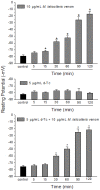Neuromuscular activity of Micrurus laticollaris (Squamata: Elapidae) venom in vitro
- PMID: 24445448
- PMCID: PMC3920266
- DOI: 10.3390/toxins6010359
Neuromuscular activity of Micrurus laticollaris (Squamata: Elapidae) venom in vitro
Abstract
In this work, we have examined the neuromuscular activity of Micrurus laticollaris (Mexican coral snake) venom (MLV) in vertebrate isolated nerve-muscle preparations. In chick biventer cervicis preparations, the MLV induced an irreversible concentration- and time-dependent (1-30 µg/mL) neuromuscular blockade, with 50% blockade occurring between 8 and 30 min. Muscle contractures evoked by exogenous acetylcholine were completely abolished by MLV, whereas those of KCl were also significantly altered (86% ± 11%, 53% ± 11%, 89% ± 5% and 89% ± 7% for one, three, 10 and 30 µg of venom/mL, respectively; n = 4; p < 0.05). In mouse phrenic nerve-diaphragm preparations, MLV (1-10 µg/mL) promoted a slight increase in the amplitude of twitch-tension (3 µg/mL), followed by neuromuscular blockade (n = 4); the highest concentration caused complete inhibition of the twitches (time for 50% blockade = 26 ± 3 min), without exhibiting a previous neuromuscular facilitation. The venom (3 µg/mL) induced a biphasic modulation in the frequency of miniature end-plate potentials (MEPPs)/min, causing a significant increase after 15 min, followed by a decrease after 60 min (from 17 ± 1.4 (basal) to 28 ± 2.5 (t15) and 12 ± 2 (t60)). The membrane resting potential of mouse diaphragm preparations pre-exposed or not to d-tubocurarine (5 µg/mL) was also significantly less negative with MLV (10 µg/mL). Together, these results indicate that M. laticollaris venom induces neuromuscular blockade by a combination of pre- and post-synaptic activities.
Figures





Similar articles
-
Action of Micrurus dumerilii carinicauda coral snake venom on the mammalian neuromuscular junction.Toxicon. 2002 Feb;40(2):167-74. doi: 10.1016/s0041-0101(01)00217-3. Toxicon. 2002. PMID: 11689238
-
Neurotoxicity of Micrurus lemniscatus lemniscatus (South American coralsnake) venom in vertebrate neuromuscular preparations in vitro and neutralization by antivenom.Arch Toxicol. 2019 Jul;93(7):2065-2086. doi: 10.1007/s00204-019-02476-9. Epub 2019 May 23. Arch Toxicol. 2019. PMID: 31123802
-
Pharmacological and structural characterization of a novel phospholipase A2 from Micrurus dumerilii carinicauda venom.Toxicon. 2005 Dec 1;46(7):736-50. doi: 10.1016/j.toxicon.2005.07.016. Epub 2005 Sep 29. Toxicon. 2005. PMID: 16198388
-
Electrophysiological and ultrastructural analysis of the neuromuscular blockade and miotoxicity induced by the Micrurus nigrocinctus snake venom.Acta Physiol Pharmacol Ther Latinoam. 1999;49(4):290-6. Acta Physiol Pharmacol Ther Latinoam. 1999. PMID: 10797872
-
Neurotoxicity of Micrurus altirostris (Uruguayan coral snake) venom and its neutralization by commercial coral snake antivenom and specific antiserum raised in rabbits.Clin Toxicol (Phila). 2008 Jul;46(6):519-27. doi: 10.1080/15563650701647405. Clin Toxicol (Phila). 2008. PMID: 18584364
Cited by
-
Pharmacological Screening of Venoms from Five Brazilian Micrurus Species on Different Ion Channels.Int J Mol Sci. 2022 Jul 13;23(14):7714. doi: 10.3390/ijms23147714. Int J Mol Sci. 2022. PMID: 35887062 Free PMC article.
-
Coralsnake Venomics: Analyses of Venom Gland Transcriptomes and Proteomes of Six Brazilian Taxa.Toxins (Basel). 2017 Jun 8;9(6):187. doi: 10.3390/toxins9060187. Toxins (Basel). 2017. PMID: 28594382 Free PMC article.
-
Heterologous expression, protein folding and antibody recognition of a neurotoxin from the Mexican coral snake Micrurus laticorallis.J Venom Anim Toxins Incl Trop Dis. 2016 Sep 9;22(1):25. doi: 10.1186/s40409-016-0080-9. eCollection 2016. J Venom Anim Toxins Incl Trop Dis. 2016. PMID: 27617022 Free PMC article.
-
Red-on-Yellow Queen: Bio-Layer Interferometry Reveals Functional Diversity Within Micrurus Venoms and Toxin Resistance in Prey Species.J Mol Evol. 2024 Jun;92(3):317-328. doi: 10.1007/s00239-024-10176-x. Epub 2024 May 30. J Mol Evol. 2024. PMID: 38814340 Free PMC article.
References
-
- Roze J.A. New World coral snakes (Elapidae): A taxonomic and biological summary. Mem. Inst. Butantan. 1982;46:305–338.
-
- Roze J.A. New species and subspecies of coral snakes, genus Micrurus (Elapidae), with notes on type specimens of several species. Am. Mus. Novitates. 1989;2932:1–15.
-
- Roze J.A., Bernal-Carlo A. Las serpientes corales venenosas del genero Leptomicrurus (serpentes, Elapidae) de Suramérica con descripción de una nueva subespécie. Boll. Mus. Reg. Sci. Nat. Torino. 1987;5:573–608.
-
- Aird S.D., da Silva N.J., Jr. Comparative enzymatic composition of Brazilian coral snake (Micrurus) venoms. Comp. Biochem. Physiol. B. 1991;99:287–294. - PubMed
-
- Campbell J.A., Lamar W.W. The Venomous Reptiles of Latin America. Comstock Publishers/Cornell University Press; Ithaca, NY, USA: 1989.
MeSH terms
Substances
LinkOut - more resources
Full Text Sources
Other Literature Sources

